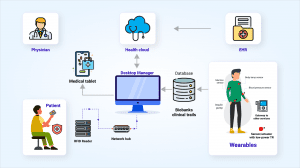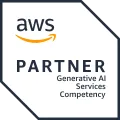Internet of Medical Things in Healthcare: A Huge Potential
TL'DR
The IoMT market is experiencing remarkable growth, projected to surge from $30.79 billion in 2021 to an impressive $187.60 billion in 2028. According to Accenture’s survey, around 62% of patients prefer virtual technology for health advice. IoMT’s efficacy in COVID-19 testing, tracking, and tracing has further highlighted its significance in healthcare.
What is the Internet of Medical Things (IoMT)?
The Internet of Medical Things (IoMT) represents medical devices and applications that connect to healthcare IT systems through online computer networks. Medical devices equipped with Wi-Fi allow the machine-to-machine communication that is the basis of IoMT. In addition, IoMT devices link to cloud platforms such as Amazon Web Services, on which captured data can be stored and analyzed. IoMT is also known as healthcare IoT.
IoMT includes remote patient monitoring of people with chronic or long-term conditions; tracking patient medication orders and the location of patients admitted to hospitals; and patients' wearable devices, which can send information to caregivers. In addition, infusion pumps that connect to analytics dashboards and hospital beds rigged with sensors that measure patients' vital signs are medical devices that can be converted to or deployed as IoMT technology.
Telemedicine which has gained much attention during the last few years, remotely monitors patients from home is also based on IoMT and wearable devices. This kind of treatment spares patients from traveling to a hospital or physician's office whenever they have a medical question or change in their condition.
Types Of IoMT Segments In Healthcare.
On-Body Wearables Segment
The on-body segment can be broadly divided into consumer health and medical and clinical-grade wearables.
Consumer health wearables include consumer-grade devices for personal wellness or fitness, such as activity trackers, bands, wristbands, sports watches, and smart garments. Most of these devices are not regulated by health authorities but may be endorsed by experts for specific health applications based on informal clinical validation and consumer studies. Companies operating in this space include Misfit (Fossil group), Fitbit, Withings, and Samsung Medical.
Clinical-grade wearables include regulated devices and supporting platforms that are generally certified/approved for use by one or more regulatory or health authorities, such as the U.S. Food and Drug Administration. Most of these devices are used with expert advice or a physician’s prescription. Examples include a smart belt from Active Protective that detects falls and deploys hip protection for elderly wearers. While Halo Neuroscience’s Halo Sport headset is worn during workouts and physical training to stimulate brain areas responsible for muscle memory, strength, and endurance. And Neurometrix Quell, a wearable neuromodulation device that taps into sensory nerves to provide relief from chronic pain.
In-Home Segment
The in-home segment includes personal emergency response systems (PERS), remote patient monitoring (RPM), and telehealth virtual visits.
A PERS integrates wearable device/relay units and a live medical call center service to increase self-reliance for homebound or limited-mobility seniors. In addition, the package allows users to communicate and receive emergency medical care quickly.
RPM comprises all home monitoring devices and sensors used for chronic disease management. They continuously monitor physiological parameters to support long-term care in a patient’s home to slow disease progression. They are also used for acute home monitoring, for continuous observation of discharged patients to accelerate recovery time and prevent rehospitalization. In medication management, they provide users with medication reminders and dosing information to improve adherence and outcomes.
Telehealth virtual visits include virtual consultations that help patients manage their conditions and obtain prescriptions or recommended care plans. Examples include video consultations and evaluation of symptoms or lesions through video observation and digital tests.

In-hospital IoMT
In-hospital IoMT encompasses a variety of devices, such as MRI machines, used for tracking hospital assets, monitoring patient flow, managing inventory (including pharmaceuticals), and optimizing other hospital resources.
Mobile IoMT
Personal Emergency Response Systems (PERS): PERS includes wearable devices or relay units connected to a medical call center, ideal for homebound individuals or seniors. These systems enable immediate communication with patients, ensuring prompt healthcare delivery.Remote Patient Monitoring (RPM): RPM supports individuals with chronic illnesses by continuously monitoring physiological parameters at home. It helps slow disease progression and aids in acute care monitoring for discharged patients to ensure ongoing recovery. RPM also assists with medication management, providing dosage reminders and enhancing patient compliance.
Public IoMT
Public IoMT, also known as community IoMT, expands healthcare access to underserved areas. This includes kiosks and vending machines equipped with connected devices that dispense medical products and services to remote locations.
Point-of-Care Devices and Kiosks
These mobile devices, ranging from ultrasound machines to blood glucose meters, gather diagnostic and health data in various settings, including doctor's offices and field locations, without requiring full laboratory facilities.
IoT: The Future of Pharma?
Pharma IoT concept involves digitalizing medical products and related care processes using smart connected medical devices and IT services (web, mobile, apps, etc.) during drug development, clinical trials, and patient care. The outcomes of Pharma IoT in development and clinical trials can employ combinations of advanced technologies and services to create new kinds of disease treatment possibilities.
For patient care, Pharma IoT will enable patients and healthcare professionals to use medicines with advanced sensor hardware and craft personalized care services and processes (Product 2.0). Good examples of the Pharma IoT solutions are the connected sensor wearables for Parkinson's disease and multiple sclerosis patients, which provide medication management, improving patient outcomes, and quality of life.
Existing medical device products such as inhalers and insulin pens can be added to the sensor and connectivity technologies to collect data for other care analytics and even personalized therapy. All this will substantially improve personal medication and care processes because patient care data provides new sources of innovation and competitiveness.
About Ideas2IT
Looking ahead, IoMT continues to drive innovation in personalized medicine and telehealth, facilitating virtual consultations and enhancing patient engagement. As IoMT technologies evolve, they promise to further optimize healthcare delivery, empower patients with greater control over their health outcomes, and pave the way for a more interconnected and efficient healthcare ecosystem.
Ready to harness the power of IoMT for your healthcare practice or organization? Explore how IoMT can streamline operations, enhance patient care, and improve outcomes. Contact us today to discuss your IoMT strategy and discover the transformative potential of connected healthcare technology. Together, let's shape the future of healthcare with IoMT.





.png)
.png)
.png)
.png)
.png)
.png)












